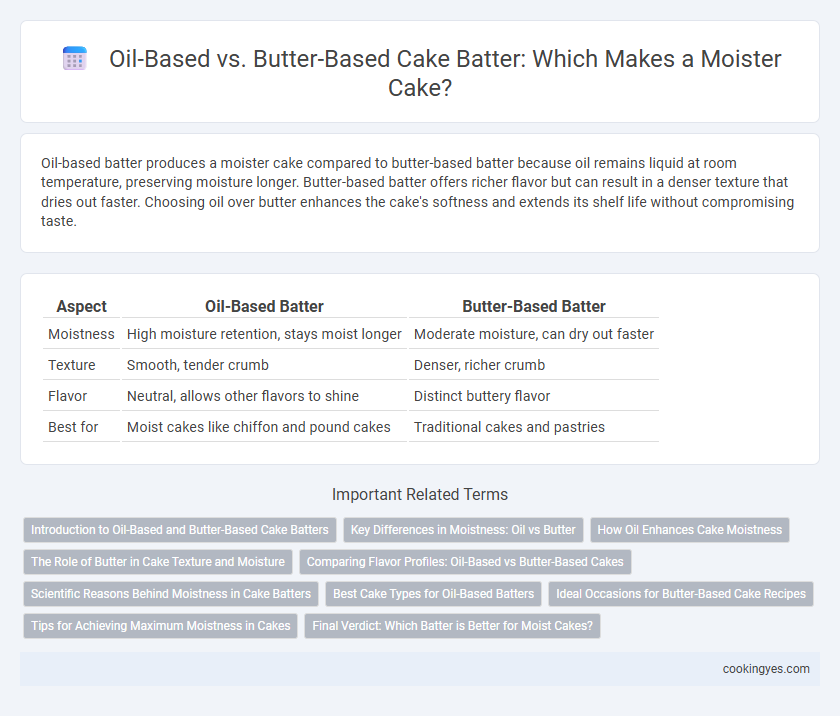Oil-based batter produces a moister cake compared to butter-based batter because oil remains liquid at room temperature, preserving moisture longer. Butter-based batter offers richer flavor but can result in a denser texture that dries out faster. Choosing oil over butter enhances the cake's softness and extends its shelf life without compromising taste.
Table of Comparison
| Aspect | Oil-Based Batter | Butter-Based Batter |
|---|---|---|
| Moistness | High moisture retention, stays moist longer | Moderate moisture, can dry out faster |
| Texture | Smooth, tender crumb | Denser, richer crumb |
| Flavor | Neutral, allows other flavors to shine | Distinct buttery flavor |
| Best for | Moist cakes like chiffon and pound cakes | Traditional cakes and pastries |
Introduction to Oil-Based and Butter-Based Cake Batters
Oil-based cake batters use vegetable or canola oil, resulting in a moist and tender crumb due to oil's ability to remain liquid at room temperature, which helps retain moisture. Butter-based batters provide a richer flavor and a firmer texture because butter solidifies when cooled, offering a distinct mouthfeel and structure. Choosing between oil and butter batters depends on the desired cake moistness and flavor intensity, with oil promoting softness and butter enhancing taste complexity.
Key Differences in Moistness: Oil vs Butter
Oil-based batter retains moisture more effectively than butter-based batter due to oil's liquid state at room temperature, preventing the cake from drying out quickly. Butter-based batter contributes to flavor complexity and structure but can result in a denser, less moist crumb as butter solidifies when cooled. The key difference in moistness lies in oil's ability to coat flour proteins, limiting gluten formation and maintaining a tender, moist texture throughout baking.
How Oil Enhances Cake Moistness
Oil-based batter retains moisture more effectively than butter-based batter because oil remains liquid at room temperature, preventing the cake from drying out. The continuous moisture distribution provided by oil results in a tender, soft crumb that lasts longer, enhancing overall cake moistness. This characteristic makes oil-based cakes particularly favorable for recipes where extended freshness and a rich texture are desired.
The Role of Butter in Cake Texture and Moisture
Butter-rich cake batter creates a tender crumb and rich flavor due to its ability to trap air during creaming, contributing to a moist and fluffy texture. The fat content in butter coats flour proteins, reducing gluten formation and resulting in a softer cake crumb. Its unique water content also steams during baking, enhancing moisture retention and preventing dryness compared to oil-based batters.
Comparing Flavor Profiles: Oil-Based vs Butter-Based Cakes
Oil-based cakes typically offer a lighter, more neutral flavor that allows added ingredients, like vanilla or spices, to shine through, while butter-based cakes provide a rich, creamy taste with caramelized, nutty undertones from butter browning during baking. The fat composition in butter enhances mouthfeel and creates a slightly denser crumb compared to the tender and moist texture of oil-based cakes. Choosing between the two depends on whether the recipe prioritizes a pronounced buttery flavor or a more subtle backdrop to showcase other flavors.
Scientific Reasons Behind Moistness in Cake Batters
Oil-based cake batters retain moisture better than butter-based batters due to the molecular structure of fats; oils are liquid at room temperature, creating a more uniform distribution of fat that inhibits gluten network formation and traps water more effectively. Butter, being solid fat with water content, partially evaporates during baking, leading to a drier crumb texture. The presence of triglycerides in oil enhances moisture retention by reducing starch gelatinization and protein coagulation rates, resulting in a moister cake texture.
Best Cake Types for Oil-Based Batters
Oil-based batters retain moisture better than butter-based batters, creating a tender and consistently moist crumb ideal for cakes that benefit from a soft texture. Best cake types for oil-based batters include chocolate cakes, carrot cakes, and spice cakes, where oil enhances flavor absorption and extends shelf life. This type of batter also excels in producing dense, rich cakes like red velvet and banana cake, where moisture retention is crucial.
Ideal Occasions for Butter-Based Cake Recipes
Butter-based cake recipes are ideal for special occasions such as birthdays, weddings, and holidays where rich flavor and tender crumb are highly valued. The butter's ability to emulsify and create a fine crumb structure results in a moist, dense texture that holds up well with elaborate decorations and fillings. This makes butter-based cakes the preferred choice for layered cakes and gourmet desserts requiring a delicate balance of flavor and moisture.
Tips for Achieving Maximum Moistness in Cakes
Oil-based batter retains moisture longer than butter-based batter due to its liquid consistency at room temperature, resulting in a consistently tender crumb. Incorporate ingredients like sour cream or yogurt to enhance moisture retention and improve texture. Bake at the recommended temperature to avoid over-drying and wrap the cake tightly after cooling to preserve softness.
Final Verdict: Which Batter is Better for Moist Cakes?
Oil-based batter retains more moisture during baking due to the liquid nature of oil, resulting in a consistently moist and tender crumb. Butter-based batter provides richer flavor and a slightly denser texture but can dry out faster as butter solidifies when cooled. For the moistest cake, oil-based batter is generally the better choice, especially in recipes that benefit from long-lasting softness.
Oil-based batter vs Butter-based batter for moistness Infographic

 cookingyes.com
cookingyes.com